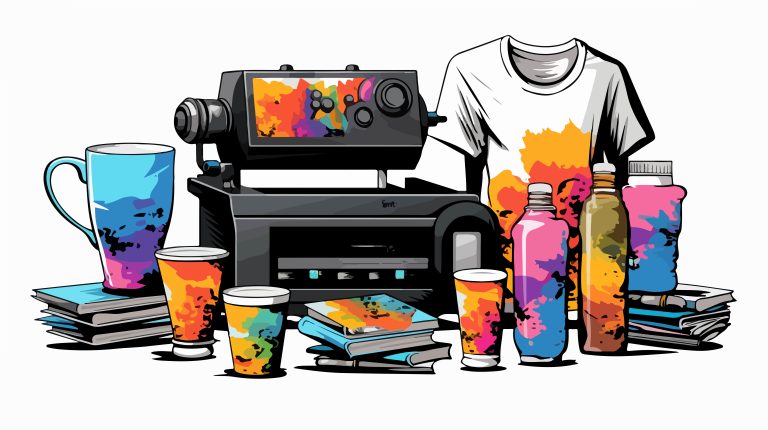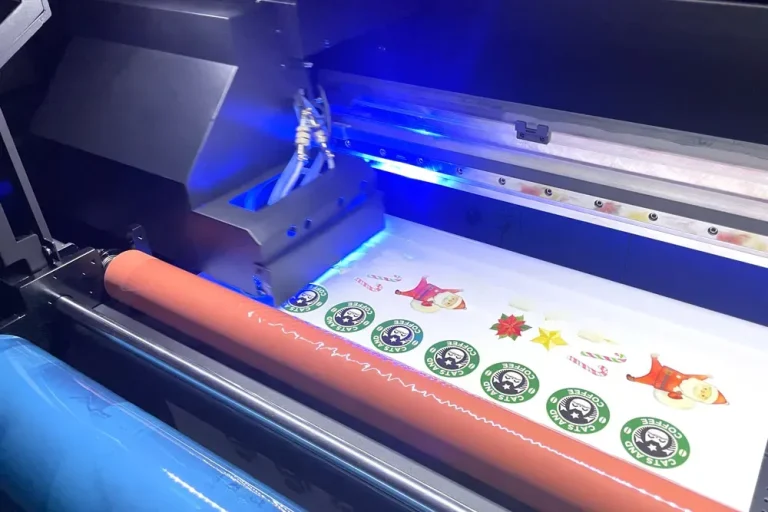UV DTF Printing: The Future of Textile Techniques Explored
In the realm of textile printing, **UV DTF printing** is revolutionizing how designs are applied to fabrics, creating a fascinating intersection of technology and creativity. This innovative approach uses UV printing technology to create vibrant, durable prints without the lengthy processing times associated with traditional methods. As sustainability in printing becomes a pivotal concern for consumers and businesses alike, UV DTF printing emerges as a leader, minimizing waste while maximizing quality. With the surge in demand for custom textile solutions, this technique caters perfectly to the personalization trend, offering diverse applications for fashion, promotional materials, and more. As we delve deeper into the mechanics and benefits of UV DTF printing, it becomes clear that this technology will shape the future of digital textile printing.
UV Direct to Film printing, often simplified as UV DTF, represents a cutting-edge method in the textile industry that utilizes ultraviolet light to cure inks onto films, which are then transferred to fabric. This modern technique not only enhances the quality of printed designs but also streamlines the overall production process, making it a favorite among manufacturers seeking rapid turnaround. Eco-friendly practices are increasingly being prioritized in the industry, and UV DTF perfectly aligns with these sustainability initiatives by reducing solvent usage and waste. Furthermore, the demand for personalized products is on the rise, and this printing method allows for custom designs that meet individual consumer preferences. As the landscape of textile printing evolves, alternative approaches like UV DTF are redefining possibilities and setting new benchmarks for quality and efficiency.
Understanding the Mechanics of UV DTF Printing
UV DTF printing technology has revolutionized the textile industry, streamlining the production process while enhancing the quality of prints. This innovative technique utilizes ultraviolet light to cure specialized inks directly onto a film, which can then be transferred onto various fabric surfaces. The ability to produce detailed graphics with vibrant colors makes UV DTF a preferred choice for businesses seeking to deliver high-quality custom textile solutions. By directly curing the inks using UV light, the entire process is not only faster than traditional methods but also more reliable, eliminating common issues such as smudging or inconsistent color application.
The mechanics of UV DTF printing involve several critical steps that highlight its efficiency. Initially, designers create intricate graphics using advanced software, which are then printed onto high-quality transfer films. The inks used in this method are designed to withstand rigorous production demands, ensuring longevity and vibrancy in the final product. Once the printing phase is complete, the UV light instantly cures the inks, solidifying the design for immediate transfer to textiles like cotton, polyester, or blended fabrics. This seamless interaction between design, printing, and curing technology ensures a smooth workflow, setting a new standard in textile printing.
Benefits of UV DTF Printing for Sustainable Textile Solutions
One of the standout benefits of UV DTF printing is its commitment to sustainability within the textile printing landscape. As consumers worldwide become more environmentally conscious, the demand for eco-friendly printing solutions continues to rise. UV DTF technology aligns with these sustainability goals by utilizing fewer solvents and producing less waste compared to traditional printing methods. This reduction in harmful materials not only lessens the environmental impact but also ensures safer working conditions for operators, making it a win-win situation for both manufacturers and the planet.
Additionally, the durability of UV DTF prints contributes to sustainability efforts by extending the lifespan of printed textiles. UV-cured prints are known for their resistance to fade, abrasion, and washing, meaning that products last longer, reducing the frequency of replacements. This longevity directly correlates with lower consumption of raw materials, reinforcing the idea that UV DTF printing can support a more sustainable future for the fashion and textile industries. By opting for this technology, brands can showcase their commitment to environmentally friendly practices while delivering high-quality products to consumers.
Customization and Personalization Trends in Textile Printing
In today’s market, the push for customization and personalization in textile products has reached new heights, and UV DTF printing sits at the forefront of this trend. With the rise of e-commerce and on-demand printing capabilities, consumers are increasingly seeking unique designs that reflect their individuality. UV DTF printing allows for limitless customization options, empowering brands to respond effectively to consumer demands for tailored products. This flexibility not only enhances customer satisfaction but also creates opportunities for businesses to stand out in a competitive marketplace.
Moreover, the efficiency of UV DTF printing ensures that personalized orders can be fulfilled quickly and cost-effectively. The ability to produce high-quality, custom textile solutions without extensive setup time makes this technique highly appealing for brands looking to capitalize on the growing trend of personalized fashion and promotional items. As UV DTF technology continues to evolve, it will offer even more innovative solutions, providing businesses with the tools they need to cater to an increasingly diverse and demanding consumer base.
Emerging Technologies in UV DTF Printing
The future of UV DTF printing is increasingly intertwined with advancements in technology that enhance production capabilities and output quality. Recent innovations have led to printers with higher printing speeds, improved resolution, and broader ink compatibility, empowering manufacturers to meet the fast-paced demands of the textile market. As these technologies become mainstream, businesses will be better equipped to handle short runs, quick turnarounds, and diverse fabric types—all while maintaining high standards of quality.
Additionally, the integration of digital solutions with UV DTF printing is set to transform the industry further. By incorporating artificial intelligence and automation, manufacturers can optimize their workflows, reducing downtime and improving operational efficiency. This technological synergy not only benefits producers but also leads to better customer experiences, as orders are delivered with speed and precision. As UV DTF continues to innovate, staying ahead of technological trends will be crucial for businesses seeking to leverage these advancements to enhance their competitiveness in the textile printing landscape.
Consumer Insights and Expectations in Textile Printing
As awareness grows regarding the benefits of UV DTF printing, consumer insights and expectations are shaping the future of textile solutions. Modern consumers are increasingly informed and demanding, often looking for products that combine quality with ecological considerations. This shift in consumer behavior influences brands to adopt UV DTF printing technology, which not only fulfills their need for vibrant and durable prints but also aligns with their desire for sustainable practices. Educating consumers about the advantages of UV printing technology will prove essential in fostering trust and promoting market acceptance.
Furthermore, customization has become a key expectation among today’s consumers. They are no longer satisfied with one-size-fits-all solutions; they crave unique designs that resonate with their personal tastes. UV DTF printing’s capability for high-resolution personalized designs allows brands to tap into this market trend effectively. By engaging customers with bespoke products and educating them about the possibilities of UV DTF printing, companies can build lasting relationships and ensure consumer loyalty in a rapidly evolving marketplace.
The Future Landscape of Textile Printing with UV DTF Technology
The future landscape of textile printing is bright, particularly for UV DTF technology, which is poised for significant growth. As more manufacturers recognize the advantages of this printing method, the demand for UV DTF products is expected to increase across various sectors, from fashion to interior design. The technology’s ability to produce high-quality prints efficiently while adhering to sustainable practices makes it an attractive option for a wide range of applications. This anticipated growth will likely drive further research and development initiatives, fostering an environment of continuous improvement in UV curing techniques and ink formulations.
Moreover, as consumer preferences evolve towards personalized and eco-friendly products, brands that embrace UV DTF printing will be well-positioned to capitalize on these shifting trends. The integration of digital technology with UV DTF printing will streamline production processes and enable even greater customization capabilities. With ongoing advancements, the intersection of UV DTF technology and consumer demands for sustainability and tailored solutions will shape the future of textile printing, ensuring that businesses that adapt and innovate will thrive in this dynamic industry.
Frequently Asked Questions
What is UV DTF printing and how does it work?
UV Direct to Film (DTF) printing is a modern textile printing technique that utilizes ultraviolet light to cure ink onto a special film before transferring it to fabric. The process involves creating digital designs, printing these onto film with UV inks, and then using UV light for immediate curing, followed by transferring the film onto the textile for a vibrant and durable finish.
What are the benefits of using UV DTF printing in textile solutions?
UV DTF printing offers several advantages such as increased vibrancy and detail in prints, durability against fading and wear, compatibility with various fabrics, eco-friendliness due to reduced solvent use, and cost-effectiveness for short-run or custom textile solutions.
How does UV DTF printing contribute to sustainability in the textile industry?
UV DTF printing supports sustainability in the textile industry by minimizing solvent usage, reducing waste, and utilizing energy-efficient curing processes. These practices align UV DTF printing with a green approach, appealing to environmentally conscious consumers.
What types of fabrics can be used with UV DTF printing technology?
UV DTF printing technology is versatile and can be applied to a wide range of fabrics, including cotton, polyester, and blends. This flexibility allows designers to explore numerous textile applications, from fashion items to promotional materials.
How does UV DTF printing compare to traditional textile printing methods?
Compared to traditional textile printing methods, UV DTF printing offers quicker curing times, higher print quality, and less environmental impact. Traditional methods typically involve longer drying times and higher solvent usage, making UV DTF a more efficient and sustainable option.
What future trends can we expect in UV DTF printing technology?
Future trends in UV DTF printing include enhanced digital integration, increased R&D investments leading to better inks and improved technologies, and a surge in personalized products as demand for custom textile solutions grows. Additionally, educational initiatives will help consumers recognize the benefits of UV DTF printing.
| Aspect | Details |
|---|---|
| What is UV DTF Printing? | A technique using ultraviolet light to cure ink on a special film, allowing for transfer to fabrics with high quality and durability. |
| How It Works | 1. Design creation using graphic software. 2. Printing on film with UV-curable inks. 3. Instant curing with UV light. 4. Film transfer to fabric. 5. Final touch-ups for durability. |
| Benefits of UV DTF Printing | 1. Vibrant colors and details. 2. Durable prints resistant to fading. 3. Applicable to various textiles. 4. Eco-friendly with reduced solvents. 5. Cost-effective for short runs. |
| Current Trends | 1. Enhanced technology (speed, resolution). 2. Emphasis on sustainability. 3. Rise in personalized products due to demand. |
| Future Predictions | 1. Integration with digital solutions (AI, automation). 2. Market expansion into new sectors. 3. Increased R&D investment. 4. Greater consumer awareness and demand. |
Summary
UV DTF printing represents a transformative leap in textile printing technology, revolutionizing how designers and manufacturers create vibrant and durable fabric prints. This innovative method continues to gain traction due to its ability to produce high-quality outputs swiftly while minimizing environmental impact. As the textiles landscape evolves, UV DTF printing is set to become a staple in the industry, marrying efficiency with sustainability and catering to the increasing demand for personalization. Companies that embrace this technology will not only meet market needs but also position themselves for future growth in a competitive landscape.






